Kitchen: Citrus Season
In the first of four posts about citrus, I explore recipes that call for lemons, limes, oranges, and grapefruit and need little or no cooking. N
This post features eight recipes that call for one or more citrus fruits: Lemon Citronette, Grapefruit Vinaigrette, Blood Orange Vinaigrette, Lemon-Pepper Vinaigrette, three winter salads, and Cuban-style ceviche. All of these are made without actual cooking, except for the ceviche, which is cooked in acid, not with heat.
We are used to having most citrus available 365 days a year, something air travel makes possible. But citrus is, primarily, a winter fruit. From tiny kumquats and finger limes to huge pomelos and Oro Blanco grapefruit, citrus soars in cold weather. And much of it goes unharvested. If you pay attention — which, in this case, means looking UP — when walking through urban and suburban neighborhoods, you may spot oranges, lemons, and grapefruit. There are also lower bushes and trees packed with hundreds of Meyer lemons. If you are tempted to pick, be sure to ask permission first. Most people with fruit that will go unharvested are happy to share what they have.
Lemon Citronette • Makes About ⅔ Cup
This dressing is simple and delicious; I never grow tired of it.
1 small shallot, minced 1 or 2 garlic cloves, minced 1 teaspoon grated lemon zest 2 tablespoons freshly squeezed lemon juice Kosher salt 6 tablespoons extra virgin olive oiul 1 tablespoon snipped fresh chives Black pepper in a mill
Put the shallot, garlic, and lemon zest into a small bowl or small wide-mouthed Mason jar, add the lemon juice, and let sit for 15 to 20 minutes.
Season generously with salt, add the olive oil, and either mix with a fork or small whisk or seal the jar and shake it vigorously. Add the chives, season generously with black pepper, taste, and correct for salt as needed.
The dressing is best enjoyed right away but may be refrigerated for up to 2 days.
Best Uses: Butter lettuce; butter lettuce with thinly sliced red onion and crumbled blue cheese; chickpea, celery, and tuna salad; pasta salad; sautéed fish; roasted chicken salad; Sicilian-style shellfish salad; Greek-style salad; farro salad; rice and bean salads.
Variations:
•For a creamy citronette, stir in 1 tablespoon creme fraiche and mix or shake well.
•For lime citronette, replace lemon zest and juice with lime zest and lime juice and the chives with cilantro.
Grapefruit Vinaigrette • Makes About ⅔ cup
This vinaigrette is very easy to make and is one of my favorite dressings. I enjoy it with egg salad, spooning a bit over it after I put the salad on lightly toasted bread. For other ways to enjoy this dressing, see the suggestions that follow the recipe.
2 tablespoons freshly squeezed grapefruit juice 2 tablespoons champagne vinegar or white wine vinegar 3 cardamom seeds or 1/8 teaspoon ground cardamom Pinch of sugar Kosher salt Black pepper in a mill 6 tablespoons extra virgin olive oil
Put the grapefruit juice and vinegar into a small bowl and add the cardamom, sugar, a generous pinch of salt, and several turns of black pepper. Stir to dissolve the sugar and let rest for 30 minutes so that the flavors meld and blossom.
Stir in the olive oil and enjoy right away.
Best Uses: Leafy greens; avocado and frisée salad; avocado, grapefruit, and crab salad; citrus salads; pear and smoked fish salads; chicken salads; egg salad over fresh greens; grilled chicken.
Blood Orange Vinaigrette • Makes about ½ cup
There is a subtle spicy quality to blood oranges. They are ubiquitous throughout Sicily and are increasingly available in the US.
2 tablespoons freshly squeezed blood orange juice 2 tablespoons Cabernet Sauvignon vinegar Kosher salt 4 to 6 tablespoons extra virgin olive oil Black pepper in a mill
Put the orange juice and vinegar in a small bowl, add the salt, and stir a couple of times to dissolve it. Add the olive oil, stir with a fork or whisk, and add several turns of black pepper.
Use right away.
Best Uses: Shredded greens; shredded romaine with thinly sliced fennel and fresh spearmint leaves;fennel and cucumber salad; Sicilian orange salad with red onion, black olives, and curls of an aged grating cheese.
Lemon-Pepper Vinaigrette • Makes About ⅔ Cup
This simple dressing takes just a couple of minutes and is both versatile and delicious. It inspires my belief that vinaigrettes go on almost everything we eat, even a few desserts.
2 lemons 2 teaspoons kosher salt 3 tablespoon black peppercorns, crossly crushed ⅔ cup extra virgin olive oil
Using a zester, grate the zest of one of the lemons. If you do not have a zest, use a sharp knife to remove and mince the zest. Set it aside.
Juice both lemons and combine the juice and salt, stirring until the salt is dissolved. Add the peppercorns, lemon zest, and olive oil.
Set aside until ready to use.
Variation: Use 2 to 3 limes instead of lemons.
Best Uses: Spooned over avocado and cottage cheese for a quick lunch; with steamed artichokes, broiled shrimp, and a mix of raw & cooked vegetables; with a salad of avocado, grapefruit, and roasted chicken; with grilled rare ribeye or skirt steak.
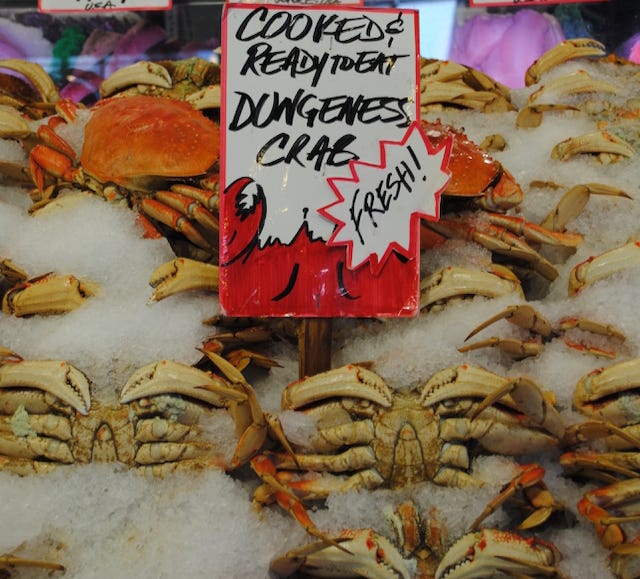
A Winter Salad with Dungeness Crab, Grapefruit, Spaghettini & Romaine • Serves 2
If you already have cooked and picked crab meat, this salad is ready in the time it takes to cook the pasta .
Kosher salt 4 ounces dry spaghettini (thin spaghetti) Meat from 1 cooked Dungeness crab, chilled Zest of 1 Meyer lemon Meyer Lemon olive oil or extra virgin olive oil 2 Meyer lemons Black pepper in a mill 8 leaves of Romaine lettuce, rinsed, dried, and cut into ½-inch wide crosswise strips 1 Oro Blanco grapefruit or 1 pomelo, peeled, sections removed from membranes
Fill a medium pot half full with water, add a tablespoon of kosher salt, and bring to a boil over high heat. When the water boils, add the pasta, stir, and cook according to package directions until just tender. Drain the pasta, rinse in cool water, and shake off any water that clings to the noodles.
Meanwhile, put the crab meat into a small bowl, add the lemon zest and drizzle with a tablespoon or so of olive oil and and the juice of half a lemon. Add several turns of black pepper, toss gently, and set aside.
Put the lettuce into a large salad bowl, sprinkle with salt and toss gently to distribute it. Drizzle with a generous splash of olive oil, enough to coat the lettuce thoroughly. Add the pasta and toss gently; if the pasta seems dry, add a little more olive oil. Add the grapefruit or pomelo and toss again. Add the juice of another half lemon, season with black pepper and taste for balance and salt. If it is a little flat, add more lemon juice and more salt.
Divide the salad between large individual bowls and spoon the crab and all its juices on top.
Cut the remaining lemon into wedges, set alongside the crab, and enjoy right away.
Winter Citrus Salad • Makes 2 to 4 Servings
To peel citrus fruit, use a very sharp knife. First, cut each end flat, removing all of the rind to expose the fruit itself. Next, set the fruit on end and use the knife to cut from top to bottom, removing the peel as well as the rind beneath it in a single cut. As you peel, you will also be shaping the fruit. When each fruit is peeled, cut away any white pith you might have missed the first time around. Serve this salad on a large clear or colored glass platter so that you can see the beautiful juices of each fruit mingling.
2 Ruby Red grapefruit, peeled 2 blood oranges, preferably Moro, peeled 3 Cara Cara oranges, peeled 3 Nova mandarins 1 Meyer lemon, peeled 1 lime, peeled 1 cup pummelo segments, all membrane removed, broken into small pieces Kosher salt 3 to 4 tablespoons ultra-premium olive oil Black pepper in a mill
Cut the grapefruit into round slices (through the equator, not the poles) about 1/8-inch thick. Arrange them in a single layer on a glass platter. Cut the oranges and mandarins into rounds slightly thinner than the grapefruit, and arrange them decoratively on top of the grapefruit. Slice the lemons and limes as thinly as possible (but not so they fall apart) and tuck them here and there, distributing them evenly throughout the salad. Scatter the pummelo wedges on top. Season with salt, drizzle the olive oil over the fruit, and add several generous turns of black pepper.
Let the salad rest at room temperature for at least 15 minutes before serving.
A Platter of Winter Jewels • Makes About 6 to 8 Servings
Once you have procured all the ingredients, putting this appetizer together is quite easy. The secret to making the assemblage of ingredients soar is getting the membranes of the citrus very crisp, so that when you bite into a segment, the chilled juices explode into your mouth. This is, of course, inspired by the late writer M.F.K. Fisher, who wrote so seductively about tangerines heated on a radiator and chilled on a snow-coated windowsill in Dijon, France, that you could just about taste them as you read.
This is an easy option for an open house or other casual gathering, with friends stopping by now and then. Quantities can, of course, be adjusted according to the number of guests.
8 Satsumas or Clementines, peeled and segmented
8 ounces feta cheese, preferably Bulgarian
Olio Nuovo or ultra-premium extra-virgin olive oil
Black pepper in a mill
8 ounces triple cream cheese, such as Brie or Camembert
Arils from 1 pomegranate
¾ cup Marcona almonds
1 pound thinly sliced jamon serrano, prosciutto, soppressata, or similar cured meat or mix of cured meats
Crackers, flatbread, or slices of toasted baguette, in a basketPreheat the oven to 225 degrees.
Set the Satsuma segments on a baking sheet; set in the oven and bake until the membranes are crisp, about 15 to 20 minutes; turn once during cooking.
Remove from the oven, transfer to a plate or bowl, preferably made of metal, and chill; I slip them into the freezer for about 30 minutes.
To serve, select a platter large enough to hold all the ingredients. Exactly how you arrange them will depend on the type of platter you are using and its size.
If using a flat wooden platter, set the feta off center, drizzle with a bit of olive oil, and grind black pepper over it. If not using a flat platter, put the feta and its toppings on a small plate.
Again, if possible, set the second cheese near the feta or else an a small plate and scatter pomegranate arils over it.
Arrange the Satsumas, almonds and pomegranates on the platter. Add the meat, folding it and tucking it here and there.
Set on a table or sideboard, with the basket of crackers or bread alongside.
Cuban-style Ceviche with Lime & Cilantro • Makes About 6 Appetizer Servings
Many people think it odd to enjoy chilled foods – vichyssoise, for example, and ceviches – in cold weather but I have always loved the contrast of something cool to eat while a fire roars in the wood stove and rain rattles the windows. It is all the better with a glass of sparkling wine alongside.
Ceviche is often thought of as raw fish but this is not accurate. Although most of us think of “cooking” as the application of heat, it is not the only way to cook. Heat breaks down hydrogen bonds in protein, a process known as denaturing. Acid also denatures protein, as it does here; it is every bit as cooked as if it had been subjected to heat.
1 cup fresh lime juice, from 8 or 9 limes 1 small white or yellow onion, minced 4 garlic cloves, crushed minced 1 serrano, seeded and minced 1 teaspoon kosher salt, plus more to taste 1 teaspoon granulated sugar, plus 2 tablespoons chopped fresh cilantro 1 tablespoon chopped fresh Italian parsley ¼ cup extra virgin olive oil (lime olive oil, if available) 1 ½ pounds raw white fish, such as snapper or Pacific halibut, cut into small dice Fresh cilantro sprigs, for garnish
In a medium bowl, combine the lime juice, onion, garlic, serrano, salt, sugar, cilantro, parsley, and olive oil. Stir, taste, and correct for salt and sugar, adding a few pinches of both if it tastes at all flat.
Put the fish into a glass bowl, pour the mixture over it, and use two forks to lift and drop the fish gently, so as not to break it up too much. Cover and refrigerate for 8 hours, stirring now and then to distribute the juices and cook the fish completely.
To serve, taste, and correct for salt as needed. Tip into a serving bowl, garnish with cilantro sprigs, and enjoy right away.
These recipes have been previously published, in my columns and in some of my books, including Vinaigrettes & Other Dressings.


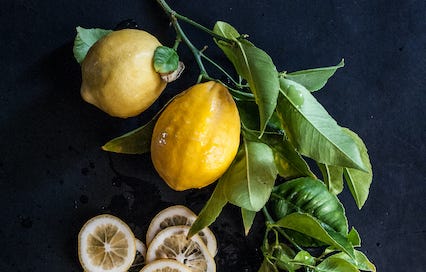


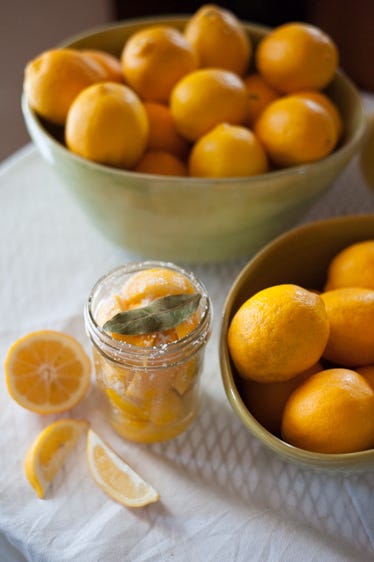
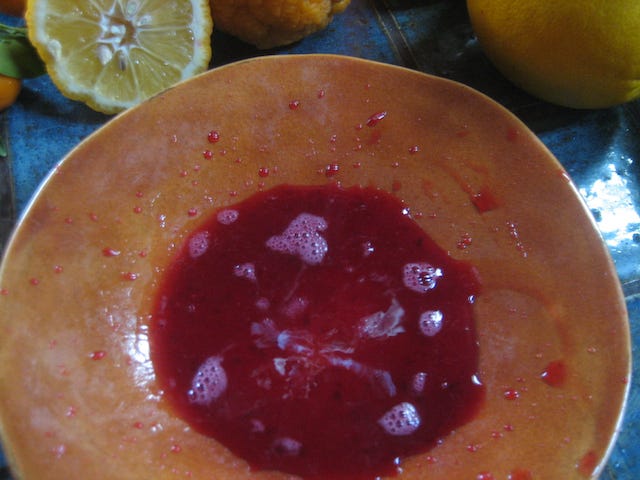
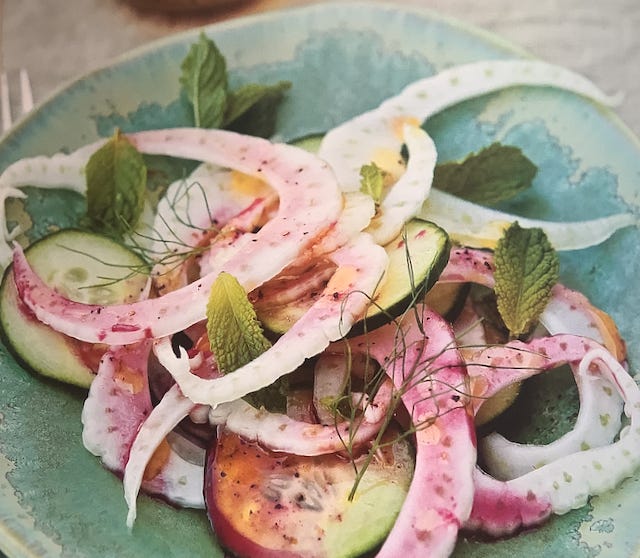
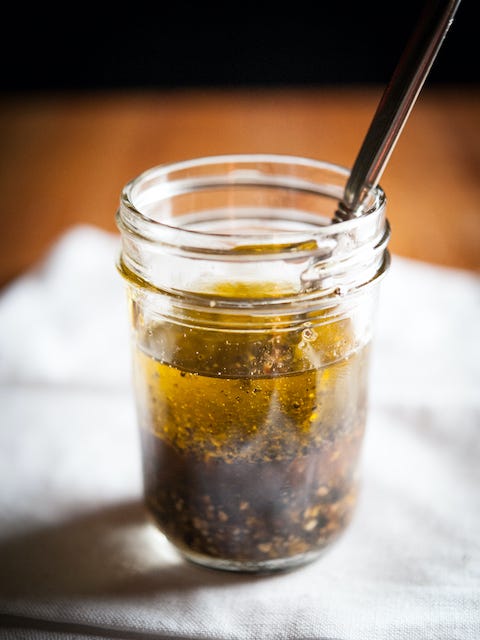
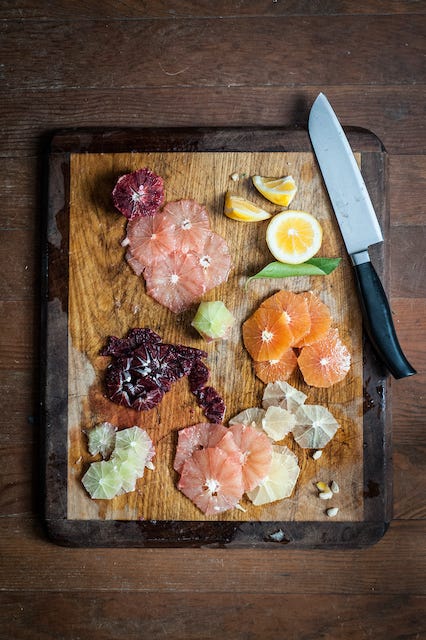
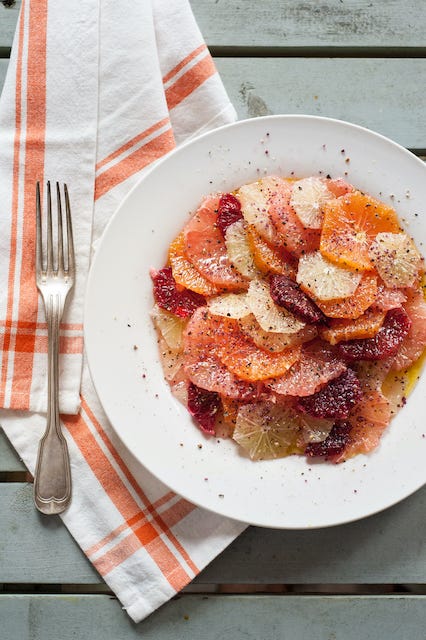

love, love, love this post. I'm crazy about citrus. I even have a "Citrus" Bible where I keep all my favorite citrus recipes. All of them are now in my bible. You are so imaginative and creative with food and displaying the heartbeat of this county in food and thought. We live in a land of bounty here in Sonoma County and you are constantly giving me new ideas. Thank you!
I shared this post with Nick, Rachel, Melissa, and Mark --I think they all have citrus trees. And I walked by a lemon tree today laden with fruit! The photos in this post are so gorgeous. I'm such a creature of habit with the simple lemon juice, olive oil, S&P that you taught me--but I vow to not to be so lazy and add some zest at the very least.